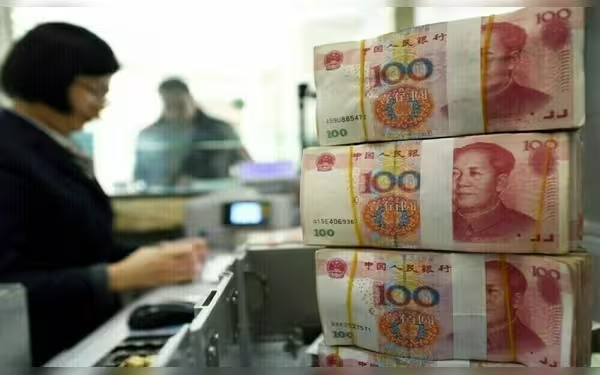Saturday, November 16, 2024 05:41 PM
Yuan Declines to Three-Month Low Amid Tariff Concerns
- Yuan hits near three-month low against US dollar.
- Tariff worries escalate following Trump's election victory.
- PBOC intervenes to stabilize yuan amid market volatility.
 Image Credits: brecorder
Image Credits: brecorderChina's yuan falls to a near three-month low due to weaker fixing and tariff concerns following Trump's election.
In recent developments, China’s yuan has experienced a significant decline, reaching a near three-month low against the US dollar. This drop is primarily attributed to a weaker official guidance rate set by the People’s Bank of China (PBOC) and growing concerns regarding potential higher tariffs on Chinese goods. These tariff worries have intensified following Donald Trump’s victory in the US presidential election, where he proposed imposing tariffs of 60% or more on imports from China as part of his strategy to bolster American manufacturing.
Historically, the yuan has shown vulnerability during periods of heightened trade tensions. For instance, during Trump’s first term, the yuan weakened by approximately 5% against the dollar when the initial round of tariffs was introduced in 2018. A further decline of 1.5% occurred a year later as trade disputes escalated. Analysts from Citi have expressed skepticism regarding the immediate reaction of Chinese policymakers to pre-election rhetoric about tariffs, suggesting that any significant adjustments would only occur once these tariffs are officially implemented.
According to Citi analysts, if a 60% tariff were to be enacted, the yuan could potentially depreciate to a range of 7.7 to 8.0 against the dollar. They anticipate that the PBOC may allow the yuan to adjust but will likely manage the timing and pace of this adjustment to mitigate market volatility. Furthermore, it is expected that the central bank will take proactive measures to defend the currency, particularly in the early stages of any tariff implementation, to stabilize market expectations and demonstrate Beijing's commitment to managing trade imbalances.
In an effort to curb the rapid depreciation of the yuan, major state-owned banks in China have reportedly been selling US dollars. As of the latest reports, the onshore yuan was trading at 7.1827 to the dollar, having reached a low of 7.1950, which is the weakest level since August 15. This decline is approaching the psychologically significant level of 7.20 per dollar. Prior to market opening, the PBOC set the midpoint rate at 7.1659 per dollar, marking its weakest point since November 17, 2023.
Market analysts, including Alex Loo from TD Securities, have noted that the PBOC's recent fixing does not indicate an excessive concern regarding foreign exchange rates at this time. Loo pointed out that the central bank has historically maintained a firmer-than-expected midpoint rate to stabilize the yuan during periods of US dollar strength. With the ongoing National People’s Congress, it is anticipated that the PBOC will continue to limit any abrupt increases in the USD/CNY exchange rate through interventions by state banks.
Looking ahead, there are speculations that if Trump secures a second term, Beijing may unveil a stronger fiscal package to counteract the economic challenges posed by his administration. The potential for increased tariffs and trade tensions could have far-reaching implications for China’s economy, making it crucial for policymakers to navigate these challenges carefully.
The current situation surrounding the yuan and the looming threat of tariffs underscores the delicate balance that China must maintain in its economic policies. As global trade dynamics continue to evolve, the actions taken by both the US and China will be pivotal in shaping the future of their economic relationship. Observers will be keenly watching how these developments unfold, as they could significantly impact not only the yuan but also the broader global economy.













